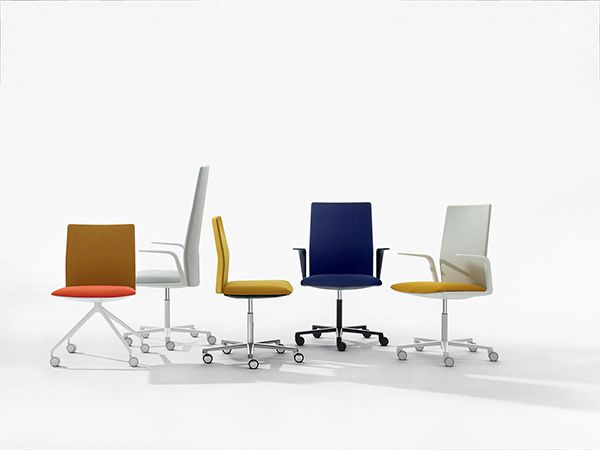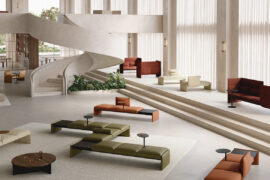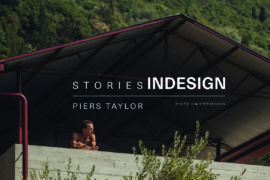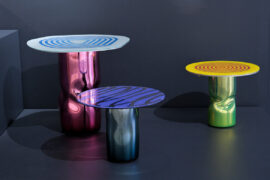Arper has been creating fluid, flexible and comfortable furniture, fitting for any living or working space since 1989. We caught up with Arper CEO Claudio Feltrin on a brief visit to Sydney to discuss Arper’s origins, the thinking behind the Kinesit task chair, and the lasting approach that sets them apart.

May 23rd, 2016
Indesign Co-Editor, SOPHIA WATSON: Can you tell me about the origins of Arper?
Arper Chairman of the Board and Director, CLAUDIO FELTRIN:
Arper was established in 1989, so it’s quite a young company considering turnover that we have, and the design, and the competitors that we have right now. The first 10 years, most of the products were sub contracted by other companies, then slowly we began to get in touch directly with designers. So from 1995 we started a new approach.
The real Arper began in 2000 when I met Alberto Lievore, who is still the art director, and a friend, and the most important designer that we have. He’s never travelled to Australia but we are working on this – he’s scared of flying! In 2000, Alberto and I came out with the duna chair, which was the first product that really showed the change in direction, and this was followed by other similar products.
For Arper, we’re focused on working to the shortest lead-time, and a greater level of customisation, as we feel this is really what the architect needs. Then the architect can really put their signature on the project.
WATSON: Long lead times are a really big issue in Australia, because we’re so isolated – it’s difficult to get anything on the spec in less than six weeks.
FELTRIN: Yes, that is the problem that you’re suffering here – the lead-time. But the feeling amongst architects is the same in Mexico, in Italy, in Scandinavia. They want to be the protagonist; they don’t want to want to work with too many products. They want to be able to customise, so in the end it feels more aligned with their design choice, and they can make their customer feel a little more unique. This is the challenge for us. For us, the architect is the real customer. So we focus on a few items, but make those items very deep – so the architect can pick and find any destination for use, instead of working on a very broad, or wide range of products.
WATSON: I think architects need to solve problems too, which brings me to my next question. The ‘Soft Tech’ concept for the Kinesit task chair has been developed to solve some of these design problems. Why do you think integrated technology is so important?
FELTRIN: We’ve often been asked why Arper hasn’t created a task chair, so we started to consider an aesthetic and design that might be a right fit for Arper, something that wasn’t otherwise available in the market. We didn’t create a new system or a new mechanism; we worked on something that had been developed before, but we decided to build it in a way that no mechanism is shown. Our design is very feminine, the lines are very soft – and we wanted to follow this through with the office chair.
WATSON: This would have been difficult; the office chair is traditionally very masculine!
FELTRIN: Yes – we wanted to create something that was the opposite of the market, which was the purpose. It was difficult, because there were many elements we couldn’t change, standards that we had to respect. And design typically has the opposite approach – starting from design, and how it looks, and then building the chair around that concept. Our approach was quite opposite.
WATSON: You mentioned Arper is really feminine in it’s aesthetic. I totally agree. Do you think that this is the way that commercial spaces are heading, they’re becoming less masculine and more feminine?
FELTRIN: We are absolutely convinced, even from when we came on the scene. From the beginning that was the trademark of Arper, design products that were more flexible, comfortable. Italian designers can often forget about comfort, the purpose of design is to be different, so they experiment and they get lost. It’s a piece of art, but then you start to wonder how you can use it! Our idea has been completely the opposite, let’s do something that is nice, but also comfortable and flexible, deep and not wide. We looked at the office in the early 2000s, and everything was very masculine in its shape, and we believe that there was a lot of room in the market for lines that were more cosy, timeless, sleek and comfortable.
In the last few years, the office space is changing. There are collaborative areas, working station needs to be adjustable, and the classic office as it was before no longer exists. We’ve noticed this at trade fairs like ORGATEC. We feel we were the first to really notice and appreciate these changes. But we aren’t an office furniture company; we’re a company offering a 360-degree solution.
The latest from Arper is available in Australia exclusively at Stylecraft.
Stylecraft will be hosting Arper Work/Life in their Sydney and Melbourne Showrooms from May 23rd – 27th. Join them in the showroom to see the latest collections from Arper. More information on stylecraft.com.au.
Stylecraft
stylecraft.com.au
INDESIGN is on instagram
Follow @indesignlive
A searchable and comprehensive guide for specifying leading products and their suppliers
Keep up to date with the latest and greatest from our industry BFF's!

A curated exhibition in Frederiksstaden captures the spirit of Australian design
The new range features slabs with warm, earthy palettes that lend a sense of organic luxury to every space.

Welcomed to the Australian design scene in 2024, Kokuyo is set to redefine collaboration, bringing its unique blend of colour and function to individuals and corporations, designed to be used Any Way!

London-based design duo Raw Edges have joined forces with Established & Sons and Tongue & Groove to introduce Wall to Wall – a hand-stained, “living collection” that transforms parquet flooring into a canvas of colour, pattern, and possibility.

Where style and substance truly dwell, Gardam’s latest modular collection – available through Stylecraft – balances elegance and versatility.

Andrea Mulloni is the head of sustainability at furniture manufacturer, Arper. With a particular emphasis on the evolving Catifa Carta chair, we chatted to him at Arper’s stand during Milan Design Week.
The internet never sleeps! Here's the stuff you might have missed

Piers Taylor joins Timothy Alouani-Roby at The Commons to discuss overlaps with Glenn Murcutt and Francis Kéré, his renowned ‘Studio in the Woods,’ and the sheer desire to make things with whatever might be at hand.

Despite its long and rich history, signwriting is a profession in decline. Will Lynes’ new show, Oily Water at Canberra Glassworks, aims to showcase the techniques of the trade to highlight its potential in design.